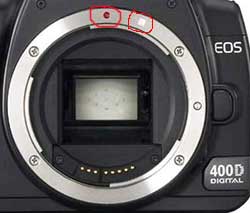Pre 2003, all Canon digital SLR cameras were compatible with a standardized EF lens. EF stands for electo-focus and refers to its lens mount. You can recognize EF lenses by its red dot, where you line up the dot on the lens mount to a similar looking one on the camera body.
However, if your Canon camera lens has both a red dot and a white square to line up the body to when mounting the lens, then it is an EF-S lens. EF-S is stands for ‘short back focus’. EF-S lenses were first developed in 2003, when Canon bought out its EOS 300D/Digital Rebel/Kiss range of digital SLR cameras.
What are the main differences between an EF and EF-S lens?
- The differences between the two lenses are purely cosmetic. The EF-S lens has been made to sit deeper into the camera’s body when connected. Hence the reason EF-S stands for short back focus, as there is less space between the lens and the sensor.
- The idea behind developing EF-S lenses in the first place, was to create a more cost effective solution (especially when talking about wide angle zoom lens), aimed at the mid range SLR camera user. Therefore, this is usually considered a good thing as far as beginners are concerned.
- Many experts have noticed no differences in the end result of the actual photograph.
Are there any disadvantages to EF-S lens?
- The main disadvantage to using an EF-S lens is that they are only compatible with Canon EOS cameras that contain both a red dot and a white square on the lens mount. The red dot means the camera supports EF-S lenses. Whereas the white square means it also supports a standard EF lens. Therefore, if in future you want to upgrade your digital SLR camera to a more professional model, you may need to also replace any lens that is an EF-S model
Considering this limitation, should you buy an EF-S lens?
- If cost is the main consideration when purchasing a quality lens, then yes certainly think about purchasing an EF-S lens. Personally my favorite all purpose lens is an EF-S 17-85MM f4-5.6 IS USM that I purchased with my camera as an upgrade to the kit lens. I find this particular EF-S lens to be very sharp and high quality. When compared to Canon’s L (professional) series, it was very low cost as well. Especially for someone first starting out in SLR photography.
- As explained earlier, if you’re planning to upgrade your camera to a more professional body any time in the future, then you may want to stick to buying an EF lens, for compatibility reasons. EF lenses are compatible with all Canon EOS camera bodies. Whereas, EF-S is only compatible with mid range camera’s (EOS 20D and Digital Rebel bodies) that support them.
How to know if your digital SLR camera is compatible with an EF-S lens?
Have a look on your digital SLR camera where the lens mounts onto the body. If you see a red circle and a white dot / square, then your camera is compatible with EF-S lenses.
